
Text © Prof. Pietro Pavone

English translation by Mario Beltramini
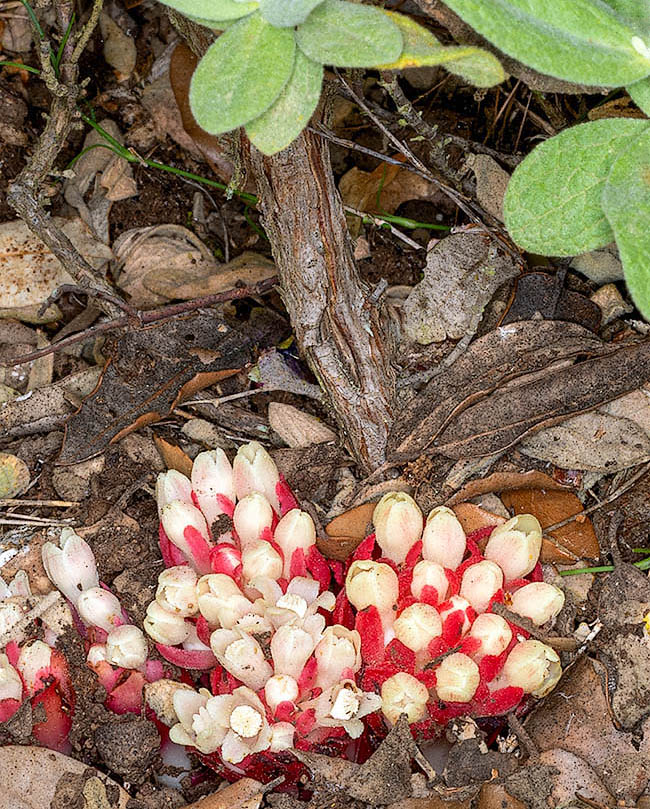
The family Cytinaceae counts only two genera of parasite plants: Bdallophytum diffused in Mexico and Central America and Cytinus present in the Mediterranean Basin, in southern Africa and in Madagascar © Giuseppe Mazza
Cytinaceae, family of the order Malvales, includes holoparasitic plants growing inside the host, usually small shrubs, and that emerge becoming visible only during the production of the flowers and of the fruits.
It was the French pharmacist and botanist Achille Richard (1794-1852) who, by means of morphological observations, believed that the genus Cytinus should have its own systematic category, that he called Cytineae (Dict. Class. Hist. Nat. [Bory] 5: 301 (1824).
In a recent past this family was included in the order Rafflesiaceae but morphological differences (inflorescence, perianth, pollen, ovule and seed) and molecular evidence have established its nesting inside the order Malvales (APG III, 2009).
Moreover, after a molecular phylogenetic study together with methods of maximum parsimony and maximum likelihood, it has been possible to consider that the family Cytinaceae is a sister group of the neotropical family Muntingiaceae.
Presently Cytinaceae counts only two genera: Bdallophytum Eichler and Cytinus L.
The affinities between these two genera were already known by the end of the XIX century, in fact, Hermann zu Solms-Laubach (1842-1915) in his opus Rafflesiaceae (1901) gives a detailed description of Cytinus as well as of Bdallophytum, at the time considered synonymous of the genus Scytanthus.
The name of the family comes from the genus Cytinus that, in turn, comes from the old Greek “κῠτῐνος” (cytinos),
cytinus, from kytos, hollow vessel, name of the calyx of the pomegranate flower (Theophrastus and Hippocrates) as it looks like the flowers of this plant.
The genus Cytinus numbers eight species with a disjointed distribution across three main diversification centres. One in the Mediterranean area with Cytinus hypocistis (L.) L. and Cytinus ruber (Fourr.) Fritsch; another in southern Africa with Cytinus capensis Marloth, Cytinus sanguineus (Thunb.) Fourc. and Cytinus visseri Burgoyne; and the third in Madagascar Cytinus baronii Baker f., Cytinus glandulosus Jum. and Cytinus malagasicus Jum. & H.Perrier.
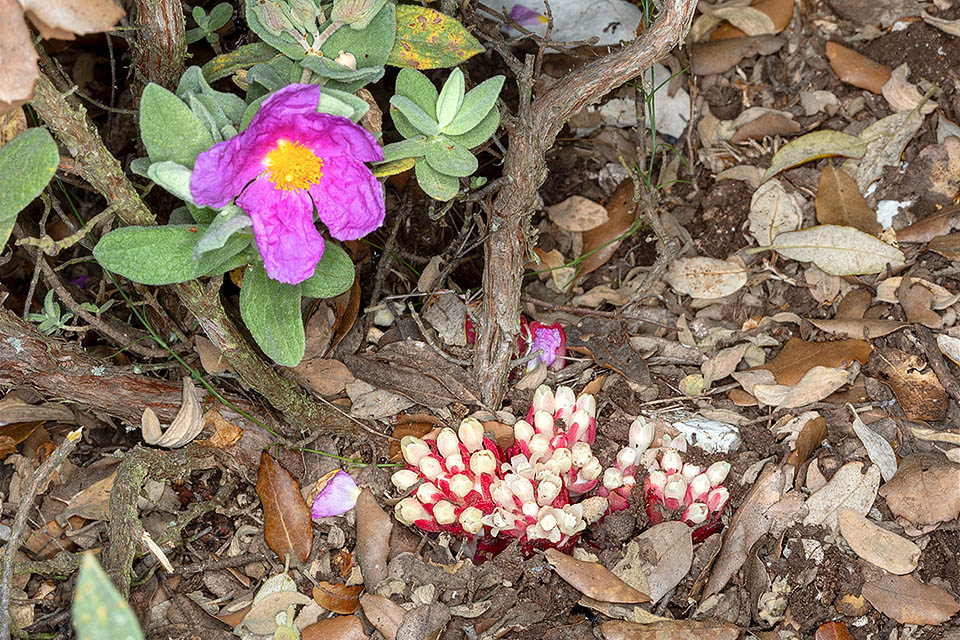
In the Mediterranean we meet Red Rockrose-Parasite (Cytinus ruber) holoparasite of pink flower Cistus plants. It’s a monoecious, perennial plant unable to photosynthesis, that develops inside its host, visible only when blooming. The inflorescence is a dense globose spike with unisexual flowers, white,yellow or pinkish © Giuseppe Mazza
The genus Bdallophytum is native to the New World (Colombia, Costa Rica, El Salvador, Guatemala, Honduras, Nicaragua and Mexico) and distinguishes from Cytinus due to some morphological characters such as the not ramified spiciform floral axis, the cherry or purple flowers and the seeds with the integument thickened by carvings.
It includes four species: Bdallophytum americanum (R.Br.) Eichler ex Solms; Bdallophytum andrieuxii Eichler; Bdallophytum caesareum (Fern.Alonso & H.Cuadros) Byng & Cheristenh.; Bdallophytum oxylepis (B.L.Rob.) Harms.
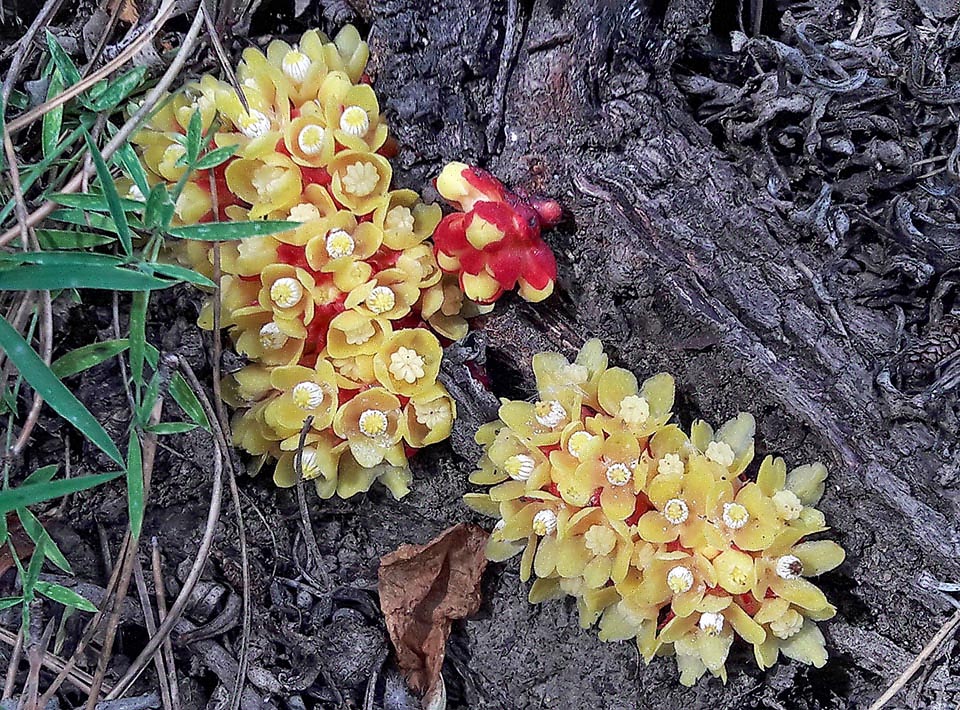
The Yellow hypocyst (Cytinus hypocistis) is also a holoparasite of Mediterranean Cistaceae, in particular of Cistus salviifolius with white flowers. Usually the flower buds form at a certain distance from the host plant but at times, like in this photo, they can emerge even very close to its roots © Miguel Ángel Bermejo Roa
The plants of this family have no leaves but only scales having no photosynthetic capacity, without stomatal openings, and have no roots. The scales are imbricated round the base of the flowers and along the axis of the inflorescence. The vegetative parts develop inside the host (roots) and are filamentous, similar to fungal hyphae. Cytinus is pretty nonspecific and may parasitize plants of different families.
Cytinus hypocistis and Cytinus ruber, typical to the Mediterranean region, have as host plants of Cistus and Halimium of the family Cistaceae.
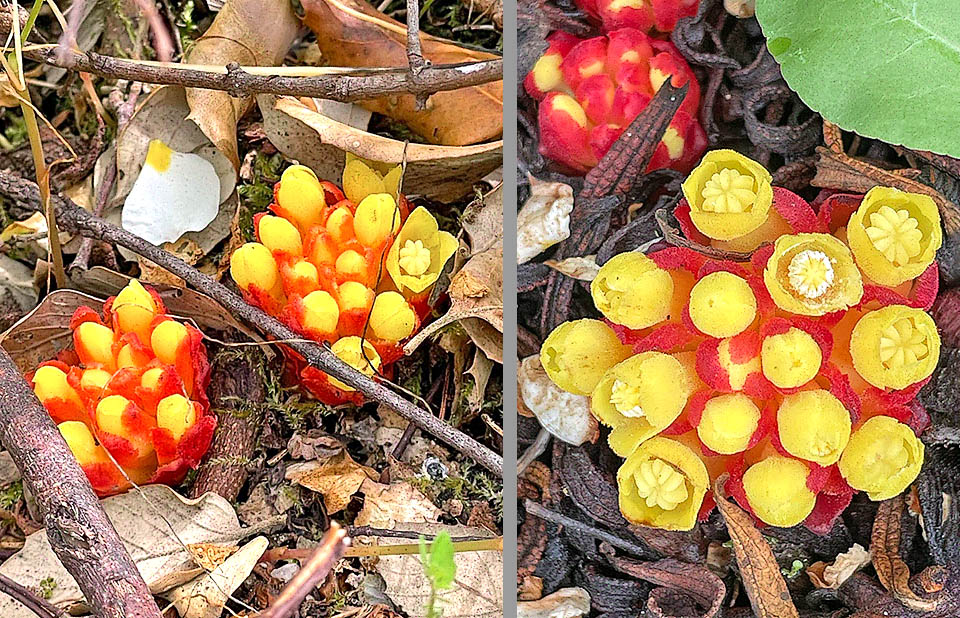
Cytinus hypocistis stem is short and covered by fleshy scales, lively coloured in yellow, with orange or red apex. The flowers are regular with a four toothed yellow perianth. The male flowers have 8 stamens with filaments merged in column and female ones have columnar style and viscous stigma © joaoalmeida (left) and © Wolff Christiane.
In southern Africa, Cytinus is seen as a parasite of species belonging to genera Metalasia, Anaxeton, Elytropappus (Asteraceae) and to a lesser extent, to the genus Passerina (Thymelaeaceae) and to some species of the family Dombeya (Malvaceae).
In Madagascar the species of Cytinus live in the humid primary forests as hosts of Croton (Euphorbiaceae); Dicoryphe (Hamamelidaceae) and Dombeya (Malvaceae).
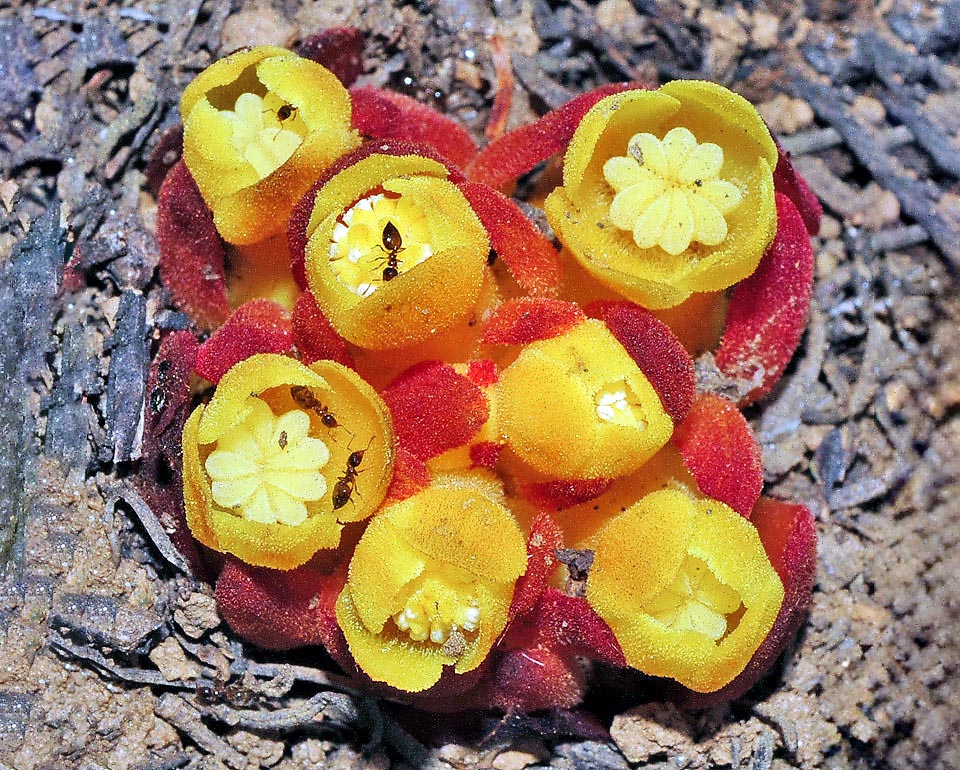
Cytinus hypocistis subsp. macranthus. Flowers are visited by several ants looking for the nectar that, in contact with stamens and pistils, carry out pollination © faluke
Bdallophytum, of the neotropical zone, is a parasite of the roots of Bursera (Burseraceae) and of species of the genera Gyrocarpus (Hernandiaceae), Haematoxylum (Fabaceae),Cochlospermum (Bixaceae), Ficus (Moraceae) and Guazuma (Malvaceae).
A study on Cytinus ruber and its akin C. hypocistis (Annals of Botany 100: 1209–1217, 2007) has highlighted the presence of similar endophytic systems, regardless of the parasitized host. They are cellular filaments that extend tangentially through the pericycle and the phloem of the root of the host to subtract elaborate for the benefit of growth of its own floriferous buds that form close to the host plant.
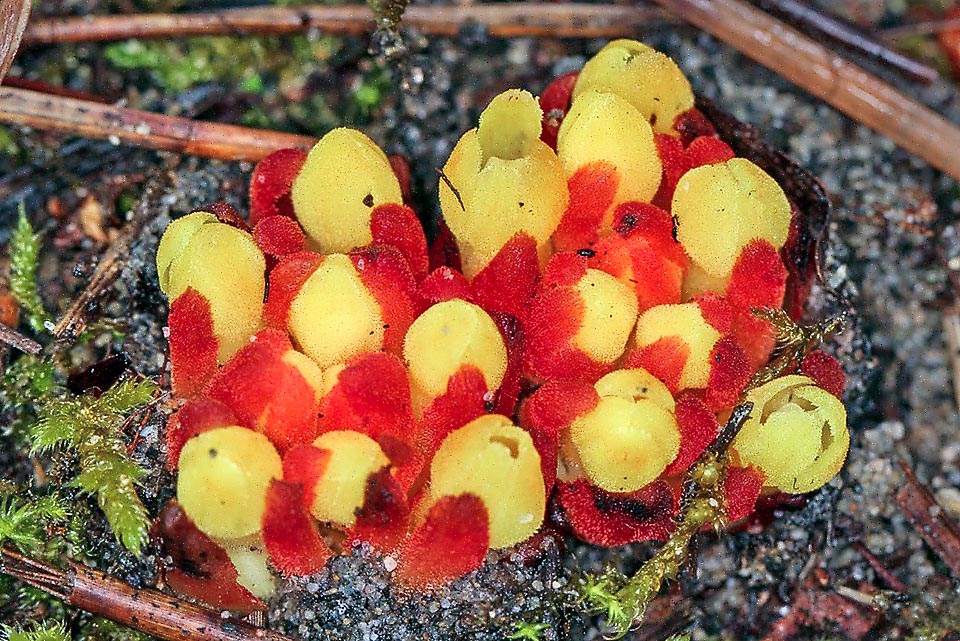
Hypocist has been used in traditional medicine to treat dysentery and throat cancers and for its astringent properties. In the past the western Mediterranean populations, during the times of famine, fed on plants of Cytinus hypocistis subsp. macranthus because they are rich in sugars, proteins, lipids and organic acids © Wettst-Luís Gaifém
The family Cytinaceae has flowers grouped in terminal spikes sometimes arranged like an umbel. The flowers can be bisexual or more commonly unisexual. Some species of Cytinus are monoecious (e.g. Cytinus hypocistis,Cytinus ruber) whilst others are dioecious (Cytinus capensis, Cytinus ghiandolelosus, Cytinus sanguineus, Cytinus visseri).
Bdallophytum americanum and Bdallophytum andrieuxii are dioecious species, that is having male and female inflorescences. Bdallophytum oxylepis is a polygamous-monoecious species that is forming hermaphroditic and male and female flowers.
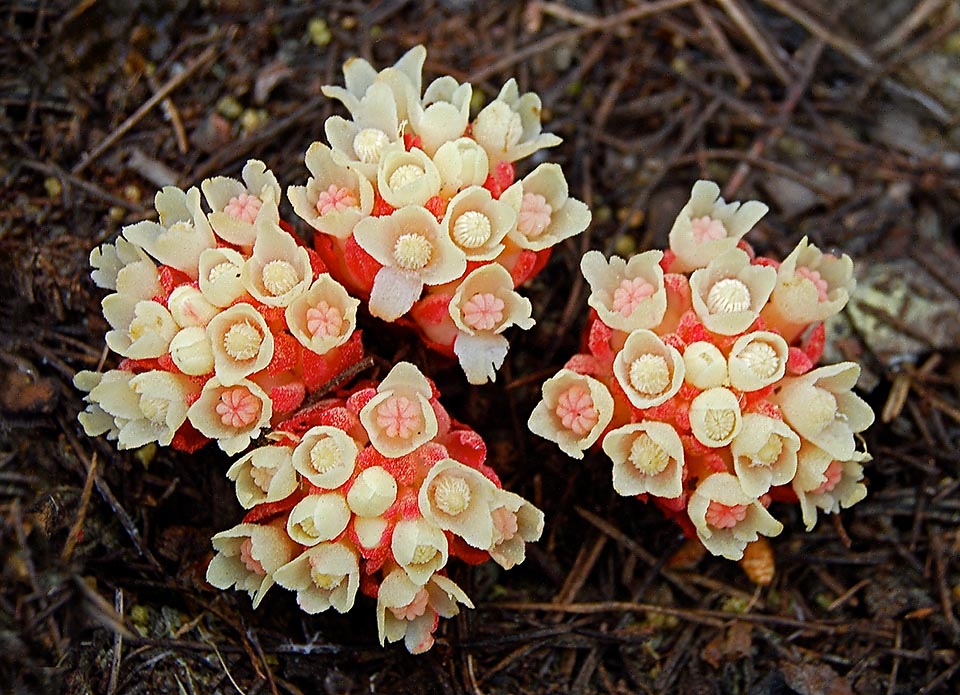
In the past Cytinus hypocistis clusii was considered a subspecies due to the deep carmine colour and bigger flowers with perigonium as long as the scales © Robert Combes
In the unisexual flowers, the male ones have the perianth formed by a tubular calyx having 4 to 9 lobes arranged imbricately, usually characterized by lively colours (red, yellow, pink, purple) whilst the corolla is absent. In the cavities, among the lobes of the perianth, are located the nectars.
In South African Cytinus are present many papillous protuberances around the edges of the cavity and may contain up to about 0,3 ml of sweet and viscous nectar.
The androecium is formed by 8 (or more) connate stamens, that is, united in one single column (monodelphous stamens).
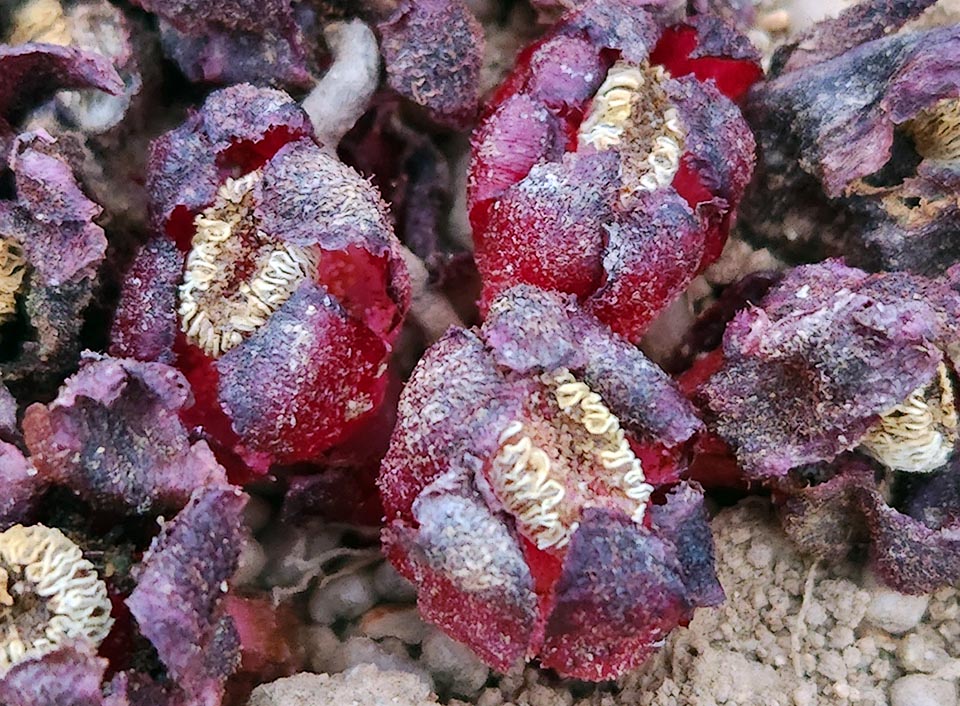
In southern Africa is present, mainly in the subtropical biome, Cytinus capensis, dioecious species typical to Cape of Good Hope province © Werner Honing
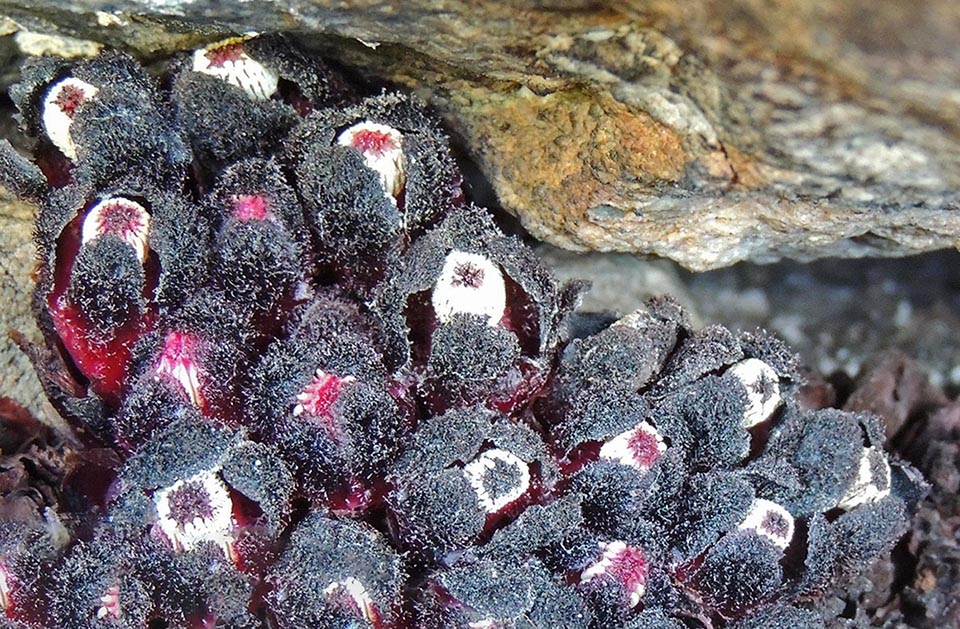
Due to urban expansion and the dense infestations of alien invasive plants, this species is considered in critical danger and, in some areas, is even considered extinct. It makes small dark flowers that emit vanilla scent and are pollinated by mice who visit the flowers for their nectar. On the photo are shown the male flowers © janeennichols
The anthers are merged like a ring on the column, at times with spurs formed by connective tissue. The spurs protrude beyond the anther and have the function of making the pollinators land. The anther sacs open with longitudinal fissures in order to release the pollen.
The pollen is spherical with many openings in Cytinus dioicus and in Cytinus sanguineus, with two openings in Cytinus ruber.
The female flowers are slightly bigger, flask-shaped in correspondence with the ovary. The calyx is tubular, with lobes smaller than the male flowers in the species of southern Africa.
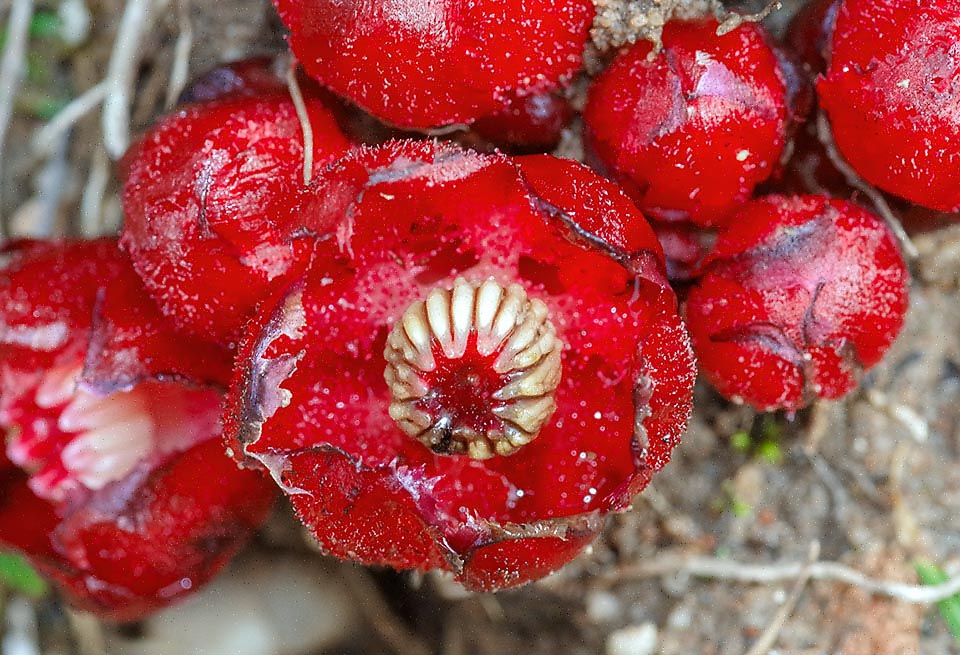
Cytinus sanguineus has robust, scarlet and odourless flowers. Male ones are characterized by the central column with anthers arranged around releasing white pollen © Craig Peter
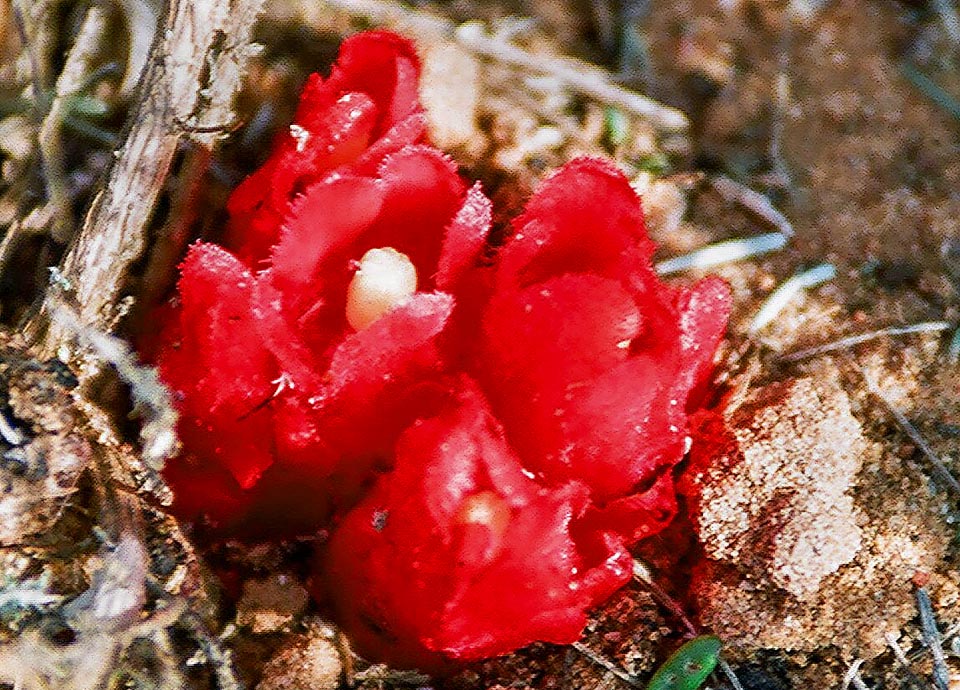
The female flowers have stigma smooth and conical in the central column. Fecundation is entrusted to small nectariniid birds that suck the nectar with long and thin beaks © Malcolm Manners
The corolla is absent and the nectars are similar to those of the male flowers, but sometimes with a bigger sugar concentration (Cytinus ruber). The gynoecium is epigynous with columnar style bearing one globose, or capitate, viscous stigma. The ovary is inferior, unilocular, with several ovules.
In Bdallophytum americanum the inflorescence emerges from the ground, after the first rains, in the month of July. The male inflorescences are the first to emerge, the female ones follow from August to September, whilst during the month of October are present only the infructescences.
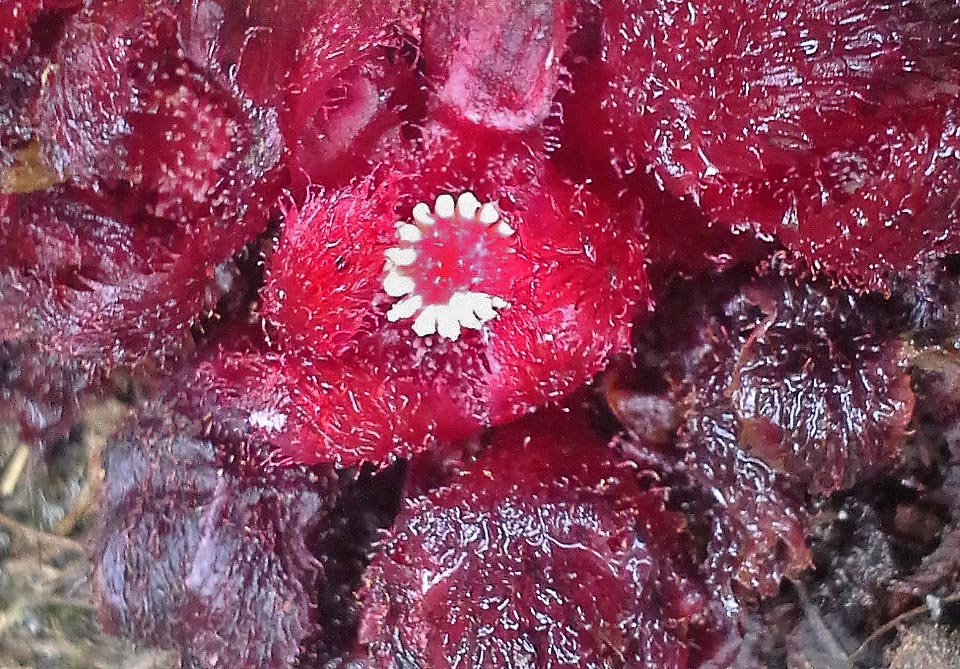
Southern Africa Cytinus visseri is a parasite of Helichrysum reflexum, a plant of Asteraceae family. Pollination is made by the mice: the Short-snouted sengi (Elephantulus brachyrhynchus) with its long and thin snout, the Four-striped grass rat (Rhabdomys pumilio) and African pygmy mouse (Mus minutoides) © Jimmy Whatmore
The pollination of the Cytinus is done by ants in the Mediterranean species as well as in the African ones but, the latter, thanks to the brightly coloured perianth, can be pollinated also by passerine birds (Nectariniidae) and by mammals.
Cytinus visseri of southern Africa is pollinated by two species of mammals, the Four-striped grass mouse Rhabdomys pumilio and the Short-snouted elephant shrew Elephantulus brachyrhynchus, attracted by the pungent scent of the flowers, due to the presence of aliphatic compounds, and by the sweet nectar.
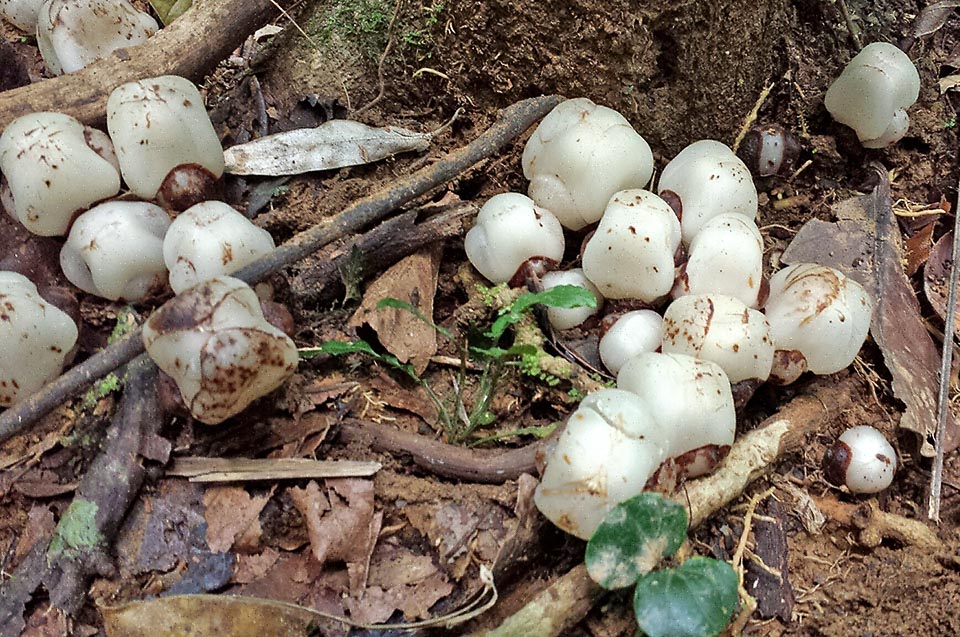
Cytinus baronii of Madagascar is the only species able to grow on the trunks of the hosts with bunches of flowers surrounded by many scaly orbicular leaves © Romer Rabarijaona
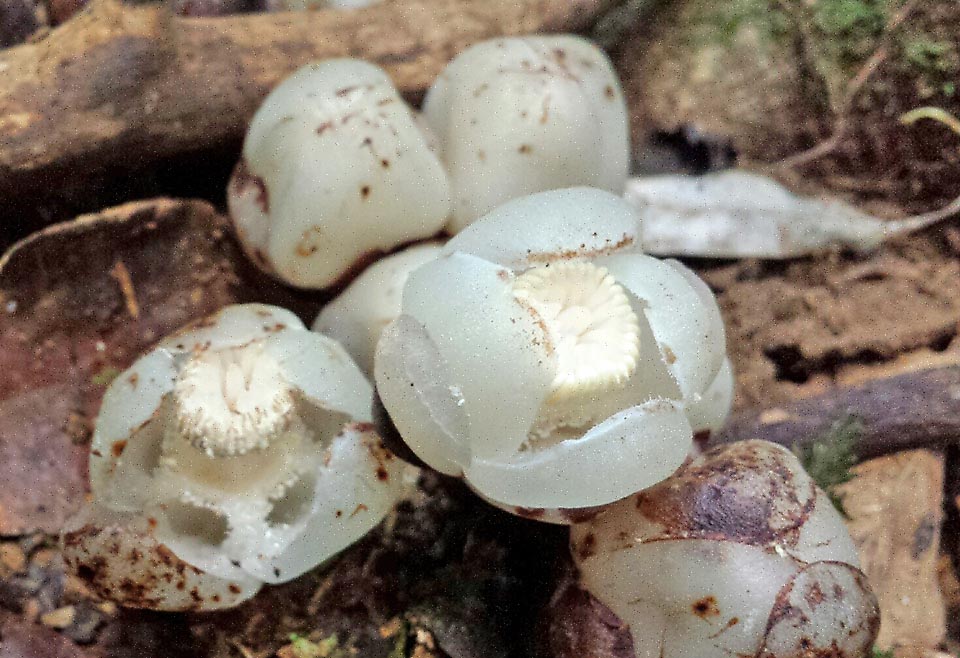
Its big male and female flowers, white and scented, offer abundant nectar to the Makagasy endemic rodents of the genus Eliurus and Nesomys (Nesomyidae) © Romer Rabarijaona
The pollination of the Malagasy species, due to the characteristic of the flowers, is done by rodents or other small mammals. In fact, recent observations done by means of infrared cameras have revealed that the flowers of Cytinus baronii are visited by the Malagasy endemic rodents of the genus Eliurus and Nesomys (Nesomyidae).
Bdallophytum is pollinated by stingless bees (Meliponini) but mainly by flies. In fact, both male and female inflorescences emit a strong odour of rotten meat. In Bdallophytum oxylepis the stingless bees seem to be more effective than the carrion flies (Calliphoridae).
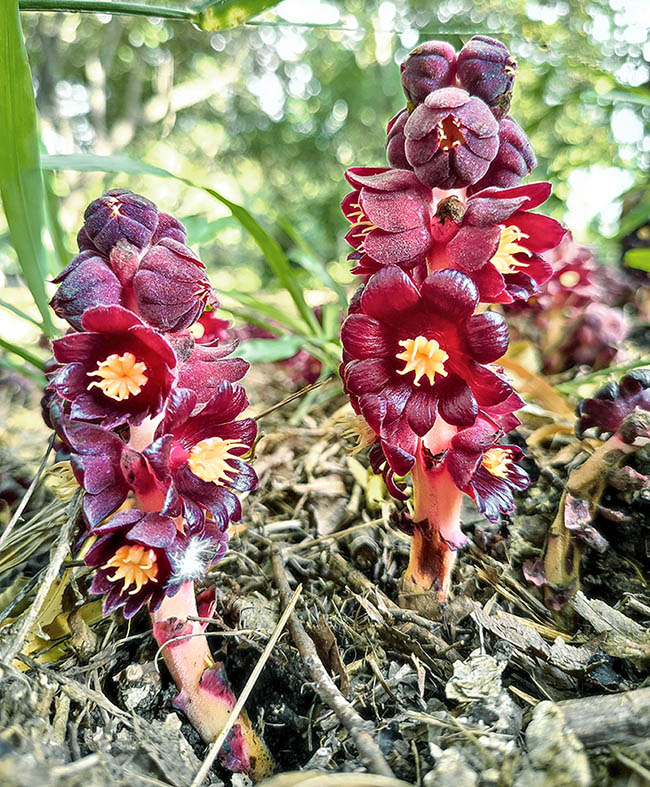
Bdallophytum americanum is a New World dioecious species. Pollination is done by stingless bees (Meliponini), by syrphids, beetles and by carrion flies attracted by the unpleasant odour of the carrions © Mariel Tortu
Bdallophytum americanum is pollinated by Syrphids (Copestylum, Syrphidae) to a lesser extent by other pollinators such as bees, beetles and flies.
The fruits of Cytinus are fleshy berries usually indehiscent. The outer integument contributes to the mucilaginous nature of the pulp of the fruit that is sweet and white, and contains several 0,2 to 0,5 mm long small seeds with outer sclerified covering.
Also the fruits of Bdallophytum are globose berries but covered by glandular hairs. The seeds have a thickened integument of yellow colour.
The chromosome number is 2n = 24 in Bdallophytum americanum and 2n=32 in Cytinus hypocistis.
Molecular phylogenetic investigations have revealed a neotropical origin of the Cytinaceae (Taxon 56 (4) 2007: 1129-1135). It is likely that the ancestor of the Cytinaceae has migrated from the New World up to continental Africa.
In fact, the closest relatives of the family stand inside the Muntingiaceae that diversified in the Americas during the Cretaceous. However, the absence of fossils of Cytinaceae does not help us in having confirmation of their migrations.
It is known how the parasites, through speciation processes, have adapted to different hosts. In fact, the host species resisting the parasitic attacks, exert selective pressures on their parasites who, in turn, evolve to resist them. Also the change in host causes speciation processes. The adaptation to new hosts, like those that are found in all species of Cytinus will have allowed new dispersion routes with the consequent colonization of new environments (Journal of Biogeography 2023,50:1852–1865). Estimates based on molecular data (single copy nuclear genes) place the origin of Cytinus at 72,1 million years ago.
Furthermore, the molecular evidence indicate that the genus Cytinus of the Old World had a divergence from the neotropical lineage in a period when the earth had a tropical climate, after the mass extinction that took place at the end of the Cretaceous-early Paleogene about 66 million years ago.
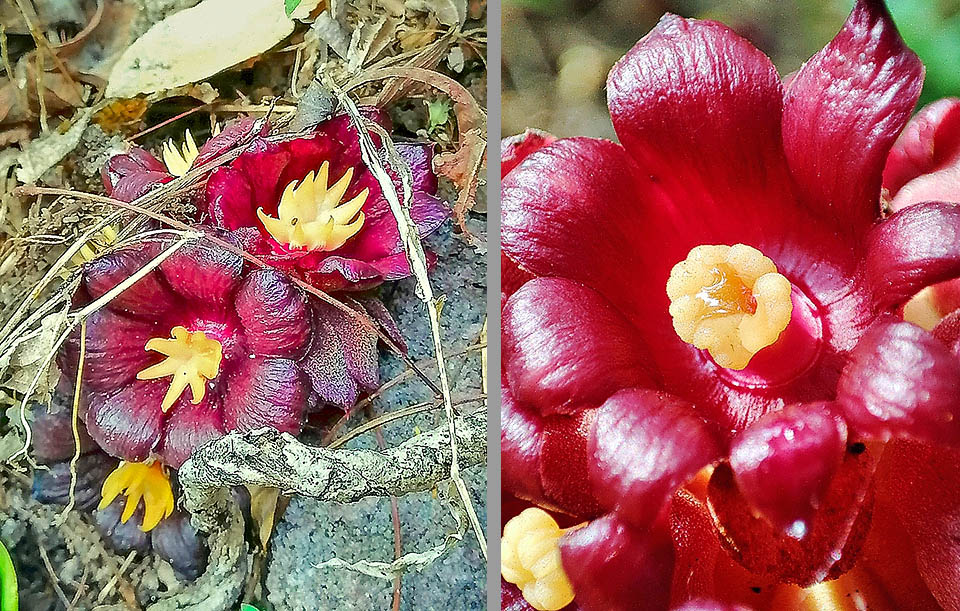
Male flowers have bright yellow staminal appendages that serve as landing platforms for the winged pollinators. The female flowers have a bright yellow stigma. In the maturation phase the flowers turn dark purple in contrast with the anthers and the stigma. To attract pollinators hey emit a strong unpleasant odour © Laura Regina (left) and © Mariel-Tortu (right)
The extinction of much of the plant biodiversity could have favoured the diversification of new evolutionary routes of the Angiosperms like the endophytic parasitism to exploit already available resources with the consequent reduction of the body structure and loss of the photosynthetic capacity.
It is estimated that the ancestors of Cytinus reached the Old World about 60 million years ago when the equatorial Atlantic Ocean was already open, therefore, it is more likely that these parasitic plants had done a transatlantic dispersion, following their hosts, reaching the tropical regions of the continental Africa.
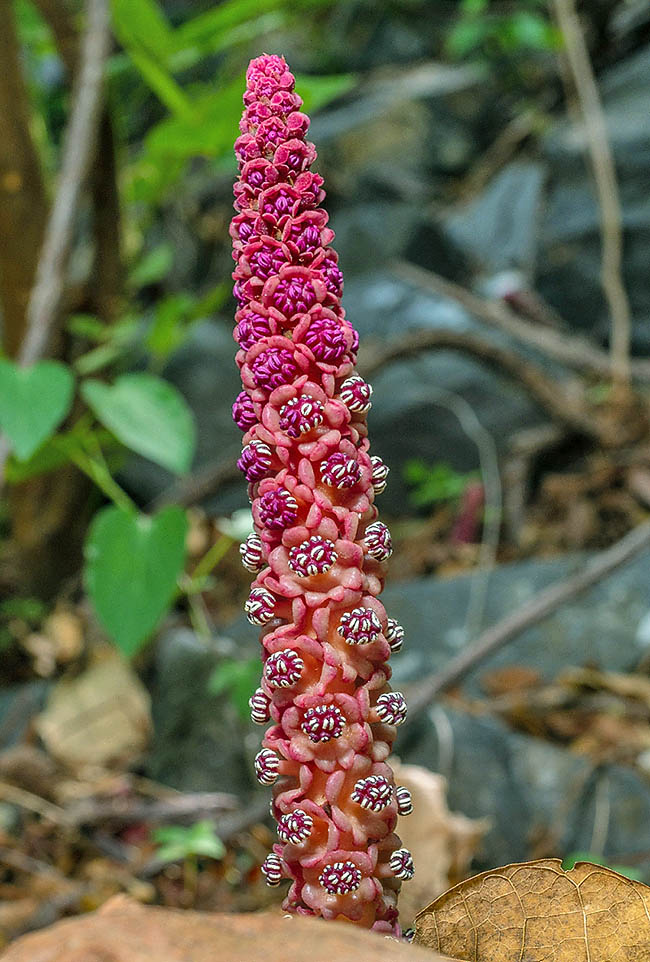
Bdallophytum andrieuxii male inflorescence. The flowers produce nectar only in the warmest hours and in quantities and concentrations similar between the female and male inflorescences. They emit rotten fruit odour accentuated by an increase of their temperature (thermogenesis) compared to the surrounding air one. The pollinators are ants, carrion flies and butterflies of the genus Cissia. The latter, during their visit, often lay the eggs in the female flowers that soon develop in larvae feeding on the fruits without however causing serious damage to seeds © rorodriguez
For the colonization of Madagascar, molecular evidences support that plants of Cytinus have undergone a transoceanic dispersion from continental Africa to this great island.
In fact the divergence of the Malagasy clade is estimated at 36 million years ago, therefore three times younger than the separation of Madagascar from continental Africa.
Fossil and phylogenetic evidence indicate the presence of a Pan-African rainforest that extended uninterruptedly between western Africa and the oriental one during the warmest period of the Paleocene and the Eocene.
It is possible, therefore, that the progenitors of Cytinus have spread together with this Pan-African forest eastwards and then have reached Madagascar, where Cytinus found refuge when the climate of the African continent became cooler and dryer.
In fact, this hypothesis is consistent with the deciduous and evergreen tropical forests occupied by Bdallophytum in America.
The genus Croton, primary host of Cytinus (Cytinus glandulosus and Cytinus baronii) in Madagascar will have had a similar dispersion path.
Hence it is probable that it also originated in the New World and has migrated into the Old World to then differentiate and disperse from Africa up to Madagascar.
The existence of ancient oceanic currents from the African coast eastwards up to Madagascar could have allowed the long-distance dispersion of animals and plants, through carpets of vegetation.
It has also been hypothesized an African-Madagascar land bridge by the end of the Oligocene, that is consistent with the presumed Malagasy lineages of Croton and Cytisus.
The gradual cooling of the global temperatures, after the warm period of Lower Eocene and up to about 33 million years ago, as well as the repeated periods of dry climate from the late Oligocene up to the Pliocene, could have caused the extinction of the Afro-tropical continental lineages of Cytisus.
It is so possible to explain the widely disjointed distribution of Cytinus that we presently observe.
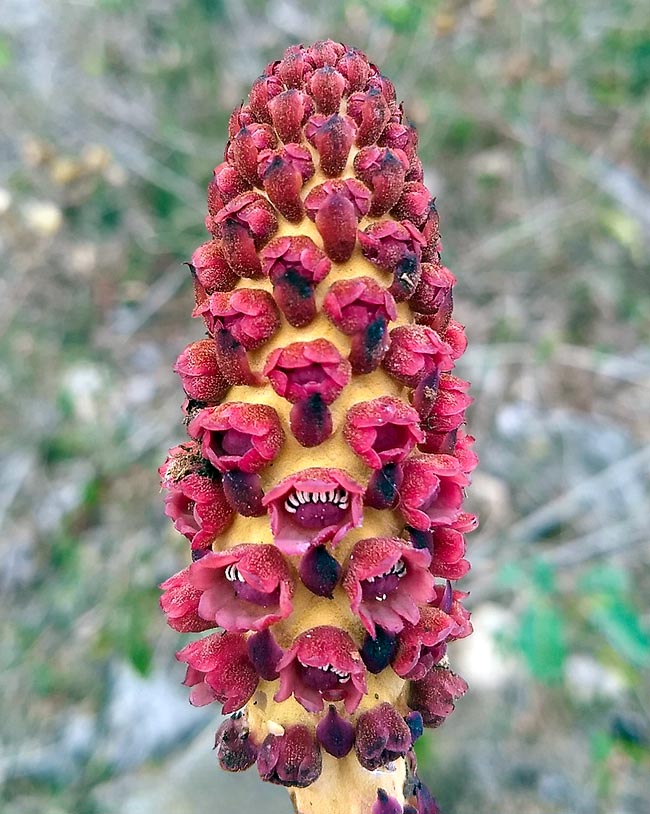
Bdallophytum oxylepis is a polygamous-monoecious species having hermaphroditic but also male and female flowers. In hermaphroditic flowers anthes are 4 to 8 and are opposite to stigma located at the apex of the staminal column. The flowers don’t produce nectar but offer abundant pollen to the stingless bees of the tribe Meliponini © ecosdelatierraac
The biogeographic reconstruction based on molecular data shows that in the Oligocene Cytinus adapted secondarily to new niches of drier climates, this gave it the opportunity of expanding in the warm temperate latitudes of southern Africa and in the Mediterranean Basin.
According to this data, the first ancestors of Mediterranean Cytinus have originated around 26 million years ago. The western Mediterranean has been probably the main centre of diversification of Cytinus, which during the Miocene, was present in south-eastern Iberian Peninsula and in northern Africa.
In late Miocene and in Pliocene, the closing of Gibraltar Strait and the salinity crisis of the Messinian might have made easier the path of dispersion from Africa and from the Iberian Peninsula, towards the whole Mediterranean Basin.
However, the sudden flooding of the same, about 5,33 million years ago, will have created discontinuity in most plant populations with disruption of the gene flow and formation of new taxa (allopatric speciation).
As a matter of fact, presently Cytinus hypocistis has 5 infraspecific taxa: Cytinus hypocistis subsp. hypocistis; Cytinus hypocistis subsp. macranthus Wettst.; Cytinus hypocistis subsp.orientalis Wettst. ex Hayek; Cytinus hypocistis subsp. pityusensis Finschow; Cytinus hypocistis subsp. subexsertum Finschow ex G.Kunkel.
Cytinus ruber has 2 infraspecific taxa: Cytinus ruber subsp. canariensis (Webb & Berthel.) Finschow ex G.Kunkel and Cytinus ruber subsp. ruber.
The niches that have originated in the Mediterranean area are different from the ancestral tropical ones, both for the climatic conditions as well as for the type of vegetation, being the Mediterranean shrubland more open than the tropical and deciduous forests.
Since ancient times, the Mediterranean Cytinus has been utilized to treat various diseases. Hippocrates and Dioscorides suggested the use of the juice of the inflorescences, assumed as drink or infusion, to treat indigestion, haemorrhages, dysentery, constipation and skin inflammation.
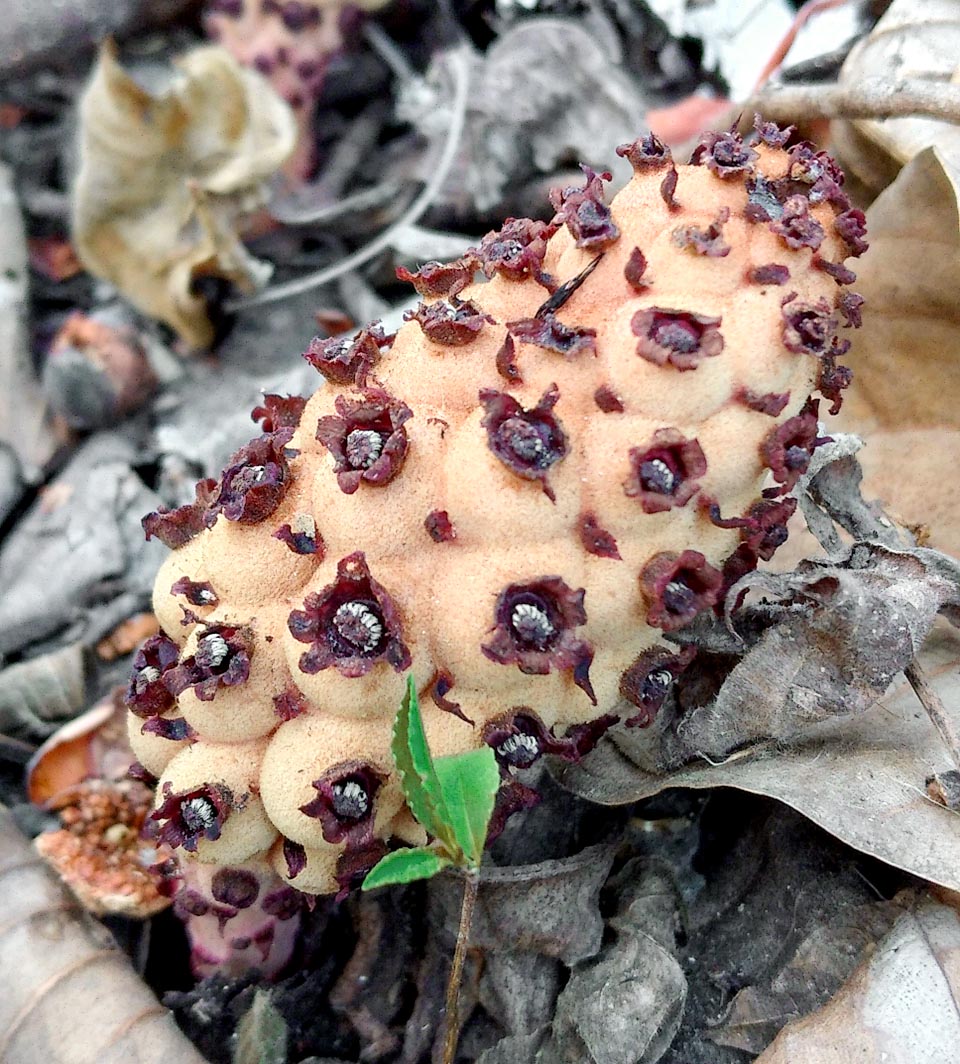
Flowers with ovaries in advanced maturation phase. In unisexual flowers without corolla, calyx is tubular with 4-9 imbricated coloured lobes: red, yellow, pink and violet © Héctor-Gómez
Pietro Andrea Mattioli (1501-1578), in his “Commentarii in sex libros Pedacii Dioscoridis Anazarbei de medica materia (1565)” has described in detail the methods of preparation and the therapeutic applications of Cytinus hypocistis.
Recent studies (Plants 2021, 10, 146), in validating such therapeutic indications, have also shown that the hydrolyzable tannins of the extracts of Cytinus hypocistis have antimicrobial, antioxidant and anti-inflammatory acitivities as well as cytotoxic activity on the cancer cells.
In the past, in the Mediterranean zone, were consumed also the inflorescences of Cytinus hypocistis and of Cytinus ruber for their nutritional properties.
